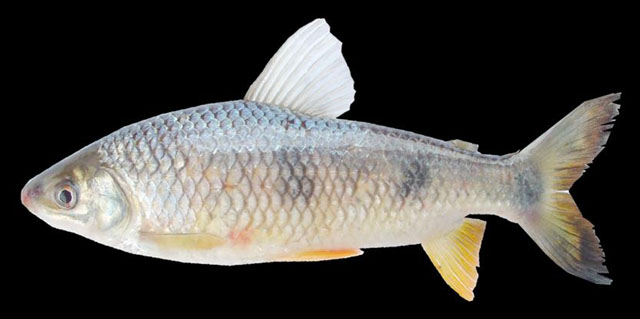|
Dorsal soft rays (total): 11-12; Anal soft rays: 10-11; Vertebrae: 39-39. Can be diagnosed from most congeners, except Leporinus amblyrhynchus, L. conirostris, L. desmotes, L. despaxi, L. elongatus, L. jatuncochi, L. macrocephalus, L. muyscorum, L. piavussu, L. reinhardti, L. trifasciatus and L. wolfei, by possessing three teeth on each premaxilla and dentary (tooth formula 3/3; vs. tooth formulae 3/4, 4/4 or 4/3). Differs from Leporinus amblyrhynchus, L. conirostris, L. desmotes, L. despaxi, L. jatuncochi, L. macrocephalus, L. muyscorum, L. reinhardti, L. trifasciatus and L. wolfei by having three dark rounded blotches on the body and dark transverse bars usually persistent in large specimens (vs. body with a dark midlateral stripe in L. amblyrhynchus, and L. despaxi; transverse dark bands in L. desmotes and L. jatuncochii; body pale except for a single dark blotch on the caudal peduncle in L. conirostris; first blotch, below the dorsal fin, transversely elongated in L. macrocephalus, L. trifasciatus and L. wolfei; transverse bars faded in large specimens of L. muyscorum; and the blotch on the caudal peduncle longitudinally elongated, not rounded, sometimes making contact with the second blotch in L. reinhardti). Can be further distinguished from Leporinus muyscorum by having six or seven scale rows between lateral line and dorsal-fin origin (vs. five); from Leporinus elongatus by having 16 scales rows around the caudal peduncle (vs. 12). Differs from a similar species Leporinus piavussu by having 41 to 43, rarely 44 perforated scales in the lateral line (vs. 39 to 40, rarely 41). Individuals of Leporinus obtusidens from the upper Rio Paraná basin can be separated from individuals of L. piavussu by having mouth directed somewhat or entirely downward, its cleft at horizontal through ventral orbital margin or slightly below (vs. mouth terminal, its cleft above horizontal through ventral orbital margin) (Ref. 93038) |

